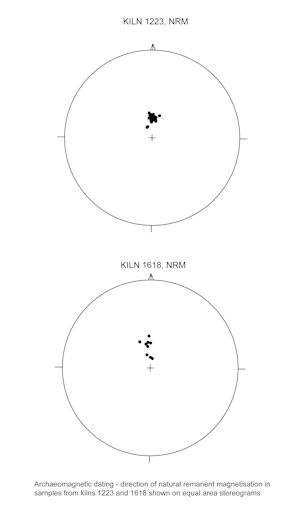
Cite this as: Noel, M.J. 2015 Archaeomagnetic Analysis of Fired Structures, in M. Atkinson and S.J. Preston Heybridge: A Late Iron Age and Roman Settlement, Excavations at Elms Farm 1993-5, Internet Archaeology 40. http://dx.doi.org/10.11141/ia.40.1.noel
This report was prepared in September 1995 and describes the integrated results of two phases of archaeomagnetic analysis of samples recovered from a total of six kilns at archaeological excavations on the site of a multi-phase settlement at Heybridge in Essex. The original reports for each phase are held in the paper archive at Colchester Museum.
The research was designed to provide a range of absolute physical dates for the last firing of each feature on the basis of the thermoremanent magnetisation. The structures selected for sampling are listed below:
Sampling: M.J. Noel, P. and N. Linford
The archaeomagnetic sampling of Kilns 1223 and 1618 was carried out on in November 1993 by the Ancient Monuments Laboratory (AML), but passed to GeoQuest Associates in June 1996 for analysis. The sampling of Kilns 14858, 10906, 11477 and 11423 was carried out in October and November 1994 and analysed by GeoQuest Associates in 1995. Each feature was first carefully examined to identify areas that were evidently in situ and where firing had been most intense. Selected surfaces were then brushed clear of loose debris and orientated samples recovered using the button method devised by Clark et al. (1988). This technique employs a 25mm, flanged plastic disc to act as a field orientation reference, sample label and specimen holder inside the laboratory magnetometer. Buttons were glued in position using a fast-setting epoxy resin (Devcon Rapid) with their surfaces set horizontal with a spirit level. Small beads of plasticine beneath the buttons held them steady while the resin cured. Finally, geomagnetic orientation arrows were marked using a Nautech fluxgate compass, along with a specimen code (it was not possible to use a sun compass at the time of sampling.) The set of orientation arrows were finally checked for parallelism to test for errors due to the bulk magnetisation within each feature; no significant flux distortion was detected in any of the kilns.
The specimens were slowly dried over several days and then consolidated by impregnation with a solution of PVA in acetone. Finally, the samples were cut with a diamond saw until each button retained a volume that fitted the standard 25x25mm specimen holder inside the archaeomagnetic magnetometer.

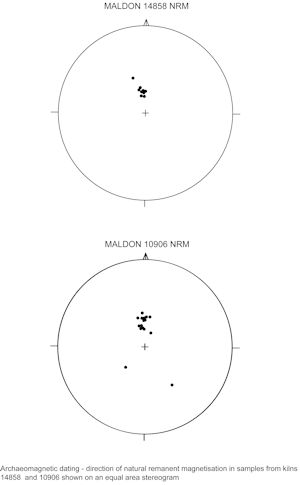
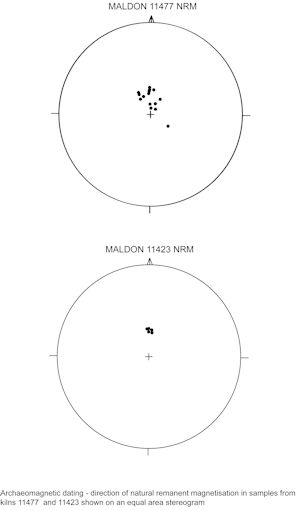
The natural remanent magnetisation (NRM) of all the samples was measured in a Molspin fluxgate spinner magnetometer (Molyneux 1971) with a minimum sensitivity of around 5x10-9Am2. Remanence directions were corrected for the local geomagnetic variation using data published by the British Geological Survey and the vectors are listed in Table 195 (.csv) plotted on the stereograms of Figures 703, 707 and 708.
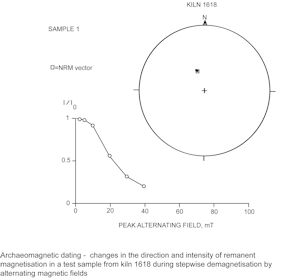
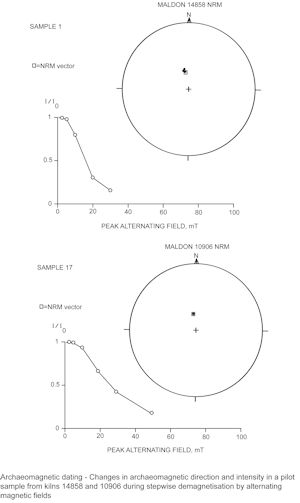
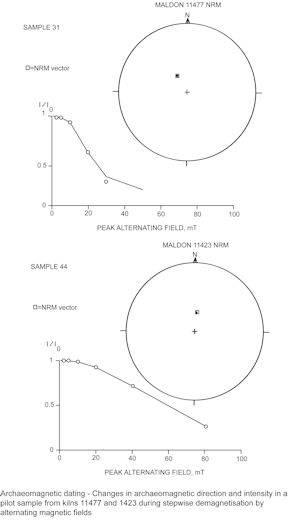
Generally, the NRM of an archaeological material will comprise a primary magnetisation (in this case presumed to be of thermal origin), together with secondary components acquired in later geomagnetic fields due to diagenesis or partial reheating. Usually, a weak viscous magnetisation is also present, reflecting a tendency for the remanence to adjust to the recent field. If the secondary components are of relatively low stability, then removal by partial demagnetisation will leave the primary remanence of archaeological interest. A pilot specimen from each kiln, with typical NRM characteristics, was demagnetised incrementally, up to a peak alternating field of 30, 50 or 80mT and the changes in remanence recorded in order to identify the components of remanence and their stability (Figures 704, 709 and 710).
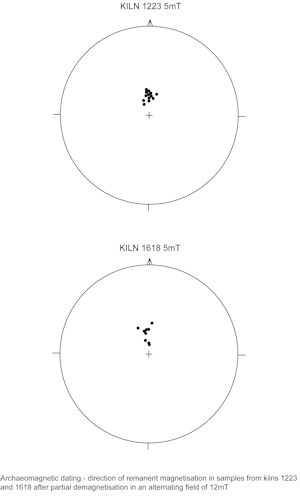
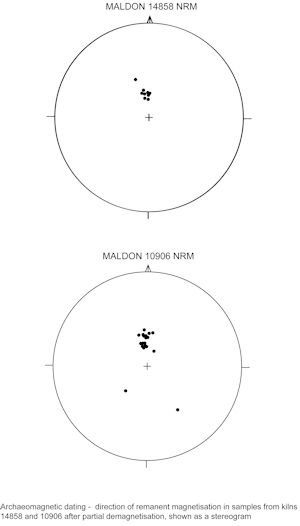

From a study of the behaviour of the pilot samples, an alternating field of 2.5mT or 5mT was chosen which would provide for the optimum removal of secondary components of magnetisation in the remaining samples. After partial demagnetisation in this field, sample remanences were remeasured and results shown on the stereograms of Figures 705, 711 and 712.
Intensities of natural remanent magnetisation in the four structures were found to be intense but inhomogeneous, indicating a variable degree of firing or concentration of the remanence-carrying mineral. The distribution of NRM vectors in each of the structures have clearly been geomagnetically controlled, providing firm evidence that they have indeed been fired to high temperatures (>680°C, assuming titanomagnetite to be the magnetic carrier).
The following are detailed descriptions of the results from each feature.
Kiln 1223 (Group 908) - Samples from this feature produced an exceptionally close grouping of NRM vectors with further improvement produced by partial demagnetisation in an alternating field of 12mT (Figure 703 and Figure 705). However, three anomalous samples contained vectors that were divergent from the main group (10, 27, 28: bracketed in Table 195) (.csv). The results from this feature are consistent with the production of thermoremanent magnetisation as a result of heating, with negligible disturbance after burial. The pilot sample demagnetisation tests by the Ancient Monuments Laboratory on Samples 15 and 20 showed that the material has excellent remanence stability.
Kiln 1618 (Group 906) - The nine samples that were analysed from this feature produced a poorer grouping of archaeomagnetic vectors than those recorded from Kiln 1223 (Figure 703). Nevertheless, some improvement was induced by partial demagnetisation in a field of 5mT (Figure 705) and the results again provide a clear indication for thermoremanence being generated by heating in the ancient geomagnetic field. Demagnetisation tests on pilot sample 1 showed that the archaeomagnetism had good stability (Fig 704). The results from all specimens are included in the subsequent analysis.
Kiln 14858 (Group 714) - All samples from lining 1436, 14725. In the stereogram of Figure 707 it can be seen that, with the exception of one outlier, the archaeomagnetic vectors in this feature are very well grouped. Stepwise, partial demagnetisation of pilot sample MAL1 (Figure 709) indicates that the magnetisation comprises a single component that is highly stable. After partial demagnetisation in an alternating field of 5mT, the grouping of the archaeomagnetic vectors changed only slightly (Figure 711) and one specimen remained as a distinct outlier. The results from this sample have therefore been rejected and it is assumed that the portion of the kiln wall from which the specimen was obtained has suffered disturbance since firing.
Kiln 10906 (Group 672) - Group number 15518: all samples from floor and sides. This structure was formed of relatively mobile tiles and blocks of fired clay. Hence great care was taken during the sampling of this structure to recover material from those areas where internal movement appeared to be least. Nevertheless, the somewhat dispersed NRM vectors seen in the stereogram of Figure 707 indicates that internal rotation of the hearth components has almost certainly taken place, with two specimens having reversed archaeomagnetic declinations. Demagnetisation tests on a sample from this feature shown that the remanence has a very high stability (Figure 709) and this is confirmed by the negligible change in the vector distribution induced by partial demagnetisation in a field of 5mT (Figure 711).The two outliers with southerly declinations were rejected from the subsequent analysis.
Kiln 11477 (Group 57) - Context 11409: five samples from pedestal; ten samples from walls. NRM archaeomagnetic vectors in this structure were again found to be rather dispersed with one outlier containing a reversed declination (Figure 708). Demagnetisation tests on a sample from the kiln wall showed this material to have a high magnetic stability (Figure 710), implying that the dispersion in NRM vectors is almost certainly the result of post-firing disturbance to the structure.
The distribution of vectors after partial demagnetisation in a field of 5mT remained largely unchanged although one specimen was unusual in reversing the remanence inclination (Figure 712). The results from two anomalous samples were rejected from the subsequent analysis.
Kiln 11423 (Group 693) - Group 693, two samples from pedestal 11569; nine samples from wall 11425 and repair 11568, 11570. Samples from this well-preserved kiln provided a remarkably well-grouped set of NRM vectors providing excellent evidence for the ancient geomagnetic field direction (Figure 708). Moreover, the results of demagnetisation tests on a pilot specimen from the kiln wall show that the material has an excellent archaeomagnetic stability (Figure 710). Negligible change in the distribution of vectors was induced by partial demagnetisation in an alternating field of 2.5mT and the results from all samples were incorporated in the subsequent analysis of this feature (Figure 712).
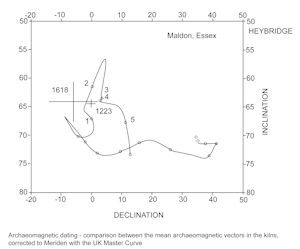

A standard correction was used to convert the mean, partially demagnetised, archaeomagnetic vector of Kilns 1223 and 1618 to Meriden, the reference locality for the British master curve (Noel and Batt 1990). Figures 706 and 713 then compare the new vectors and their associated error envelopes to the Master Curve segment 1000 BC-600 AD.
The mean archaeomagnetic vectors make closest approaches to the archaeomagnetic curve during the Roman period. A date range has been estimated by considering the extent of overlap between the vectors' circular standard error and the Master Curve. The following date ranges are thus inferred:
Kiln 1223: AD 140-170 (68% confidence)
Kiln 1618: AD 90-210 (68% confidence)
Kiln 11423: AD 225-250 (68% confidence)
Kiln 14858: Either AD 150-210 or AD 270-400 (68% confidence)
Comparisons of the mean archaeomagnetic vector in Kilns 1223 and 1618 with the UK Master Curve indicates that they were almost certainly contemporaneous and were last in use at some time during the 2nd century AD. Of the samples taken in 1994, only the results from Kilns 14858 and 11423 were judged to be of sufficient quality to warrant an attempt at dating based on the mean remanence vector. It can be seen that the mean vector in Kiln 11423 makes a closest approach to the curve in the 3rd century AD and implies a last-firing date of AD 225-250.
Although the archaeomagnetic vectors in Kiln 14858 were extremely well grouped (with the exception of one anomalous sample), it can be seen in Figure 713 that the mean direction deviates from the Roman segment of the curve by approximately 9° in declination. The kiln vector also does not coincide with the published post-Roman curve portion AD 600-present (Noel and Batt, 1990). If it is assumed that the field orientation of specimens in Kiln 14858 are in error as a result of a local geomagnetic disturbance (for example due to an adjacent pipe or other ferrous object), then an adjustment can be made to the declination in order to converge the result with the Master Curve, giving a range of possible dates of AD 150-210 or AD 270-400.
The results of this research can be summarised as follows:
Internet Archaeology is an open access journal based in the Department of Archaeology, University of York. Except where otherwise noted, content from this work may be used under the terms of the Creative Commons Attribution 3.0 (CC BY) Unported licence, which permits unrestricted use, distribution, and reproduction in any medium, provided that attribution to the author(s), the title of the work, the Internet Archaeology journal and the relevant URL/DOI are given.
Terms and Conditions | Legal Statements | Privacy Policy | Cookies Policy | Citing Internet Archaeology
Internet Archaeology content is preserved for the long term with the Archaeology Data Service. Help sustain and support open access publication by donating to our Open Access Archaeology Fund.